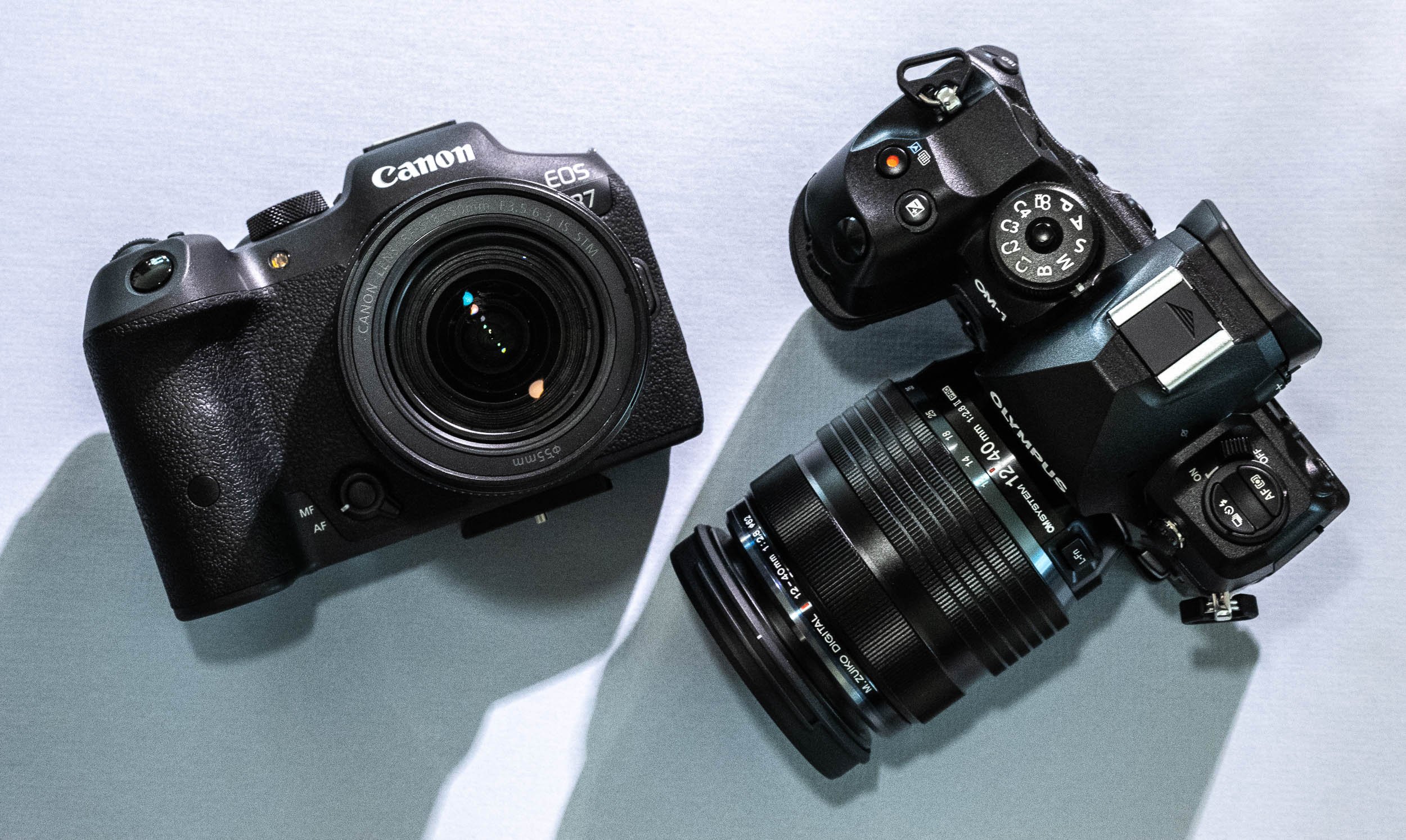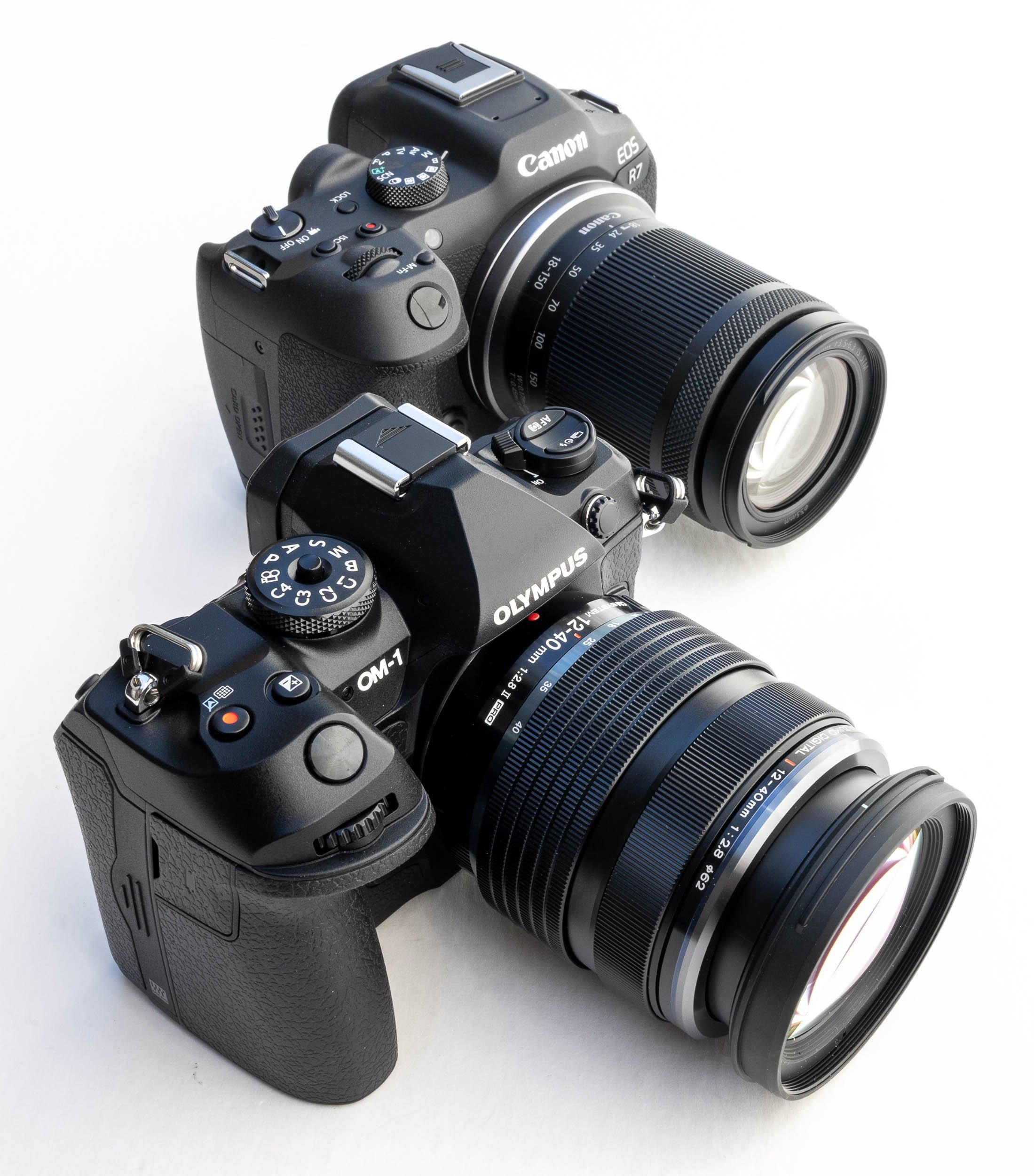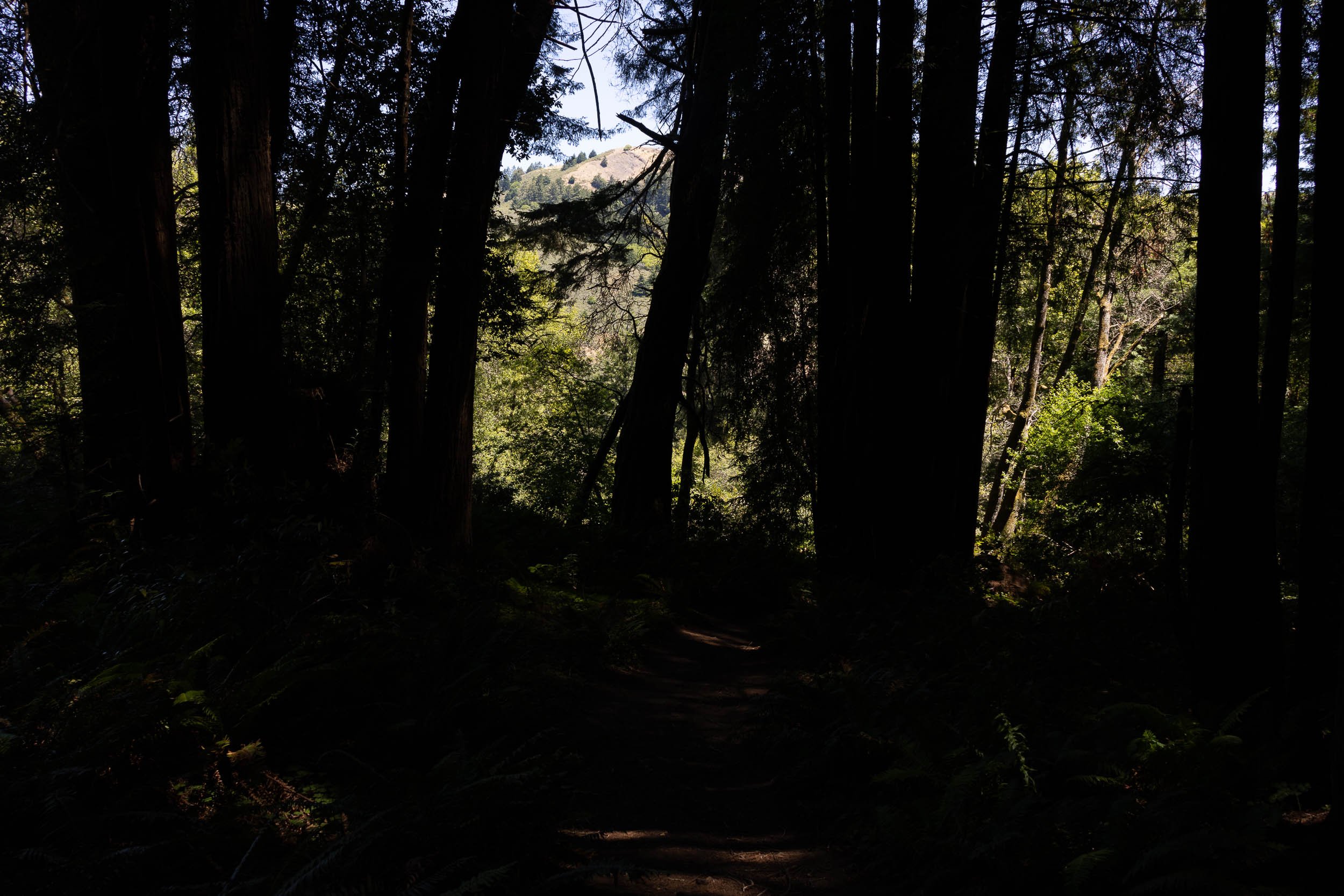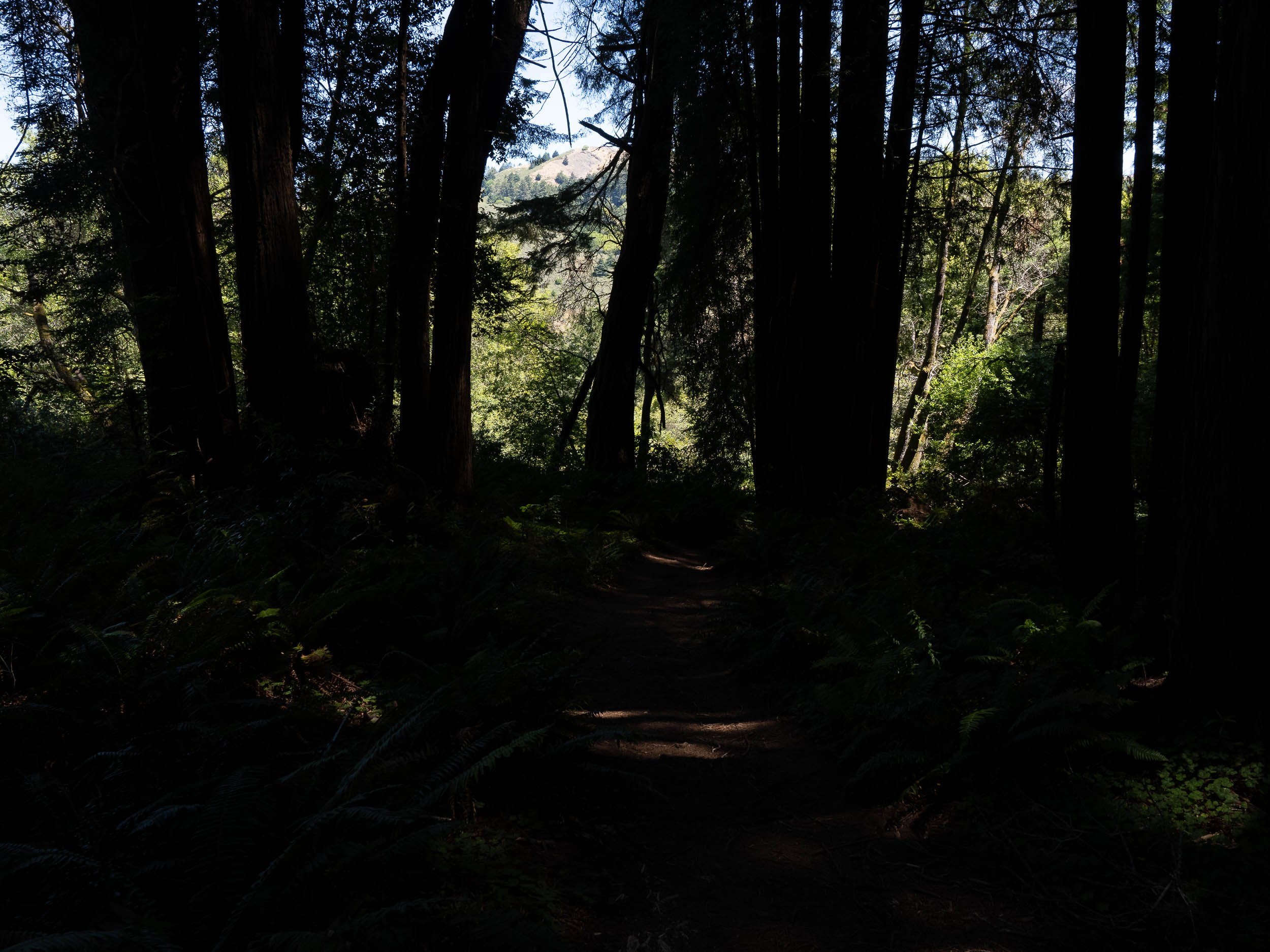Canon R7 vs. OM Systems Olympus OM-1: An In-Depth Camera Comparison & Review
Introduction
Despite the seemingly never-ending supply shortages affecting the camera space (among other industries), 2022 has turned out to be a pretty exciting year for fans of crop cameras, with a variety of new releases making it to market. For a while, it seemed as though full-frame cameras were dominating the show, but this year has proven that crop camera formats are still alive and kicking. Two new releases this year include the Canon R7 and the OM Systems OM-1. I had the opportunity to test these two crop-sensor cameras side by side and develop some thoughts about how they compare.
When comparing any gear, one always runs the risk of comparing apples to oranges, and in some ways that was unavoidable here. Notably, the prices and kit lenses included are quite different, as are the specs of the included kit lenses. The OM-1 is OM System’s current flagship camera that bears a brand-new micro four-thirds sensor, and the R7 is Canon’s current flagship “crop” APS-C camera. Though there are some definite differences between the two, there are also a lot of similarities. Anyone considering a small, but powerful system camera setup may be contemplating these two.
At the time of writing, the Canon R7 comes with the 18-150 kit lens for $1899, and the OM Systems OM-1 comes with the 12-40 F/2.8 kit lens for $2799 (or $1599 vs. $2199 body only, respectively). That’s a substantial cost spread, and it is necessary to take into account some key differences that likely contribute to those cost differences. The most substantial differences include OM Systems use of a stacked CMOS sensor and pairing a professional-grade F/2.8 kit lens with the OM-1, versus the Canon’s approach of employing a traditional non-BSI, non-stacked sensor and an enthusiast-grade superzoom kit lens. Though on paper it seems like it would be a landslide for the OM-1, in practice, there are pros and cons of each setup and which to choose will largely depend on the user’s needs and wants. Below, I take a deeper dive to evaluate the similarities and differences between these two cameras.
Both the OM Systems OM-1 and Canon R7 employ a similar design ethos, despite being from different marques and having slightly different sensor sizes (slightly larger in the R7). Both have modern-looking, contoured, rounded bodies with deep grips and ergonomic controls, as well as a LCD flip-out screen.
Design
Size, weight, grip & ergos
What is immediately apparent when comparing these two cameras is that they are almost identical in terms of size, weight, and general shape. The grip on both cameras feel very similar, with the Canon’s being slightly thicker where the fingers wrap around the camera. If someone handed me each camera with my eyes closed, I wouldn’t readily be able to tell which one I was using. Both cameras are almost identical in weight at around 600 grams. Both have a solid heft but are not unwieldy, and each would be nice hiking or travel companions, or “B” cameras to go alongside a larger full-frame rig. Neither would fit easily in a small pocket, especially with the kit lenses, but in a large vest pocket with a pancake lens - perhaps that’d work.
Both are nice cameras to hold, but as a matter of personal taste, I slightly prefer the layout of the R7 over the OM-1 ergonomically. Canon seems to know how to make even their small cameras fit like a glove and feel really nice to hold, and it shows here. The shutter button is farther forward than the OM-1’s, meaning my hand is less cramped and my pointer finger falls in just the right place. The rotary dial (which I currently have set to shutter speed), is easy to access, but admittedly it is somewhat strange to spin a rotary dial versus a classic control dial to adjust shutter speed. I am sure it is something one gets used to over time.
On the OM-1, the shutter button is set farther back, which means I have to curl my hand a bit more than I’d like to reach all the buttons, which has led to some fatigue over long shoots. If I’m nitpicking, the control dials are also a little bit too much recessed on the OM-1 for my taste, and made of a somewhat slippery plastic material. I wish they were either slightly easier to rotate like on the R7, or rubberized like on the E-M1X or some other cameras I’ve used. Certainly, the earlier E-M1X was far better for my hands ergonomically than both of these cameras, but compromises were likely made so that the OM-1 could be more compact and to have a lower starting price. Both camera bodies feel good in hand, certainly when compared to most other compact cameras I’ve held.
Both cameras have a similar grip shape with the Canon’s grip being ever so slightly chunkier and deeper. Both have twin UHS-II SD card slots behind a flap on the grip. My preference is for the Canon’s deeper grip with the shutter button farther forward. Preferences will probably vary with the user.
Build quality
Both of the cameras feel built solidly with magnesium chassis and hard plastics, and while I wasn’t brave enough to test compliance, the OM-1 has a higher water sealing rating (IP53) than the R7 (unrated). The Canon supposedly sports “90D - level” sealing, which is to say, decent but not as robust as an R3 or 1DX, for example. The additional level of sealing on the OM-1 is quite evident when examining the battery and card slot doors where the OM opts for gaskets and the R7 seems to rely on a combination of gaskets or tight tolerances. As a kit with the 12-40 lens, the OM-1 is also superior with both the lens and body bearing IP53 rating : “Protected from water spray less than 60 degrees from vertical”. This is basically a higher rating than any other interchangeable camera on the market since the long-discontinued Nikon AW1, not that I would ever recommend submerging it in water - but based on my experience with past Olympus cameras light rain showers are no issue. Both bodies feel generally similar in terms of build quality overall, though, with the slight edge to the Olympus.
The biggest difference build-wise between the OM and Canon kit is between the OM 12-40 and the RF-S 18-150 kit lenses. The Canon lens has a much cheaper all-plastic construction and a plastic lens mount, versus the all-metal design and mount of the OM 12-40 F/2.8. I wouldn’t hesitate to expose the OM-1 kit to some elements, but some care would definitely need to be taken with the aforementioned R7 kit. The 18-150 is essentially identical to the EF-M model optically, which turns out to be a good thing, but it is a shame they couldn’t improve upon build quality with some basic weather sealing. Canon seems to be going this way with all of their lower priced STM lenses.
Button placement
Right Shoulder: Starting with the shoulder of the cameras, in most ways, the R7 is “classic Canon”, with the M-Fn button adjacent to the shutter, a control dial behind the shutter, lock button, two controls (ISO and Record) and a PASM dial. The on-off-video switch is in a great place for one handed use (Canon usually puts their on-off switches on the left side of the body, for reasons unknown). The Olympus has the on-off switch in a rather annoying spot to the left of the EVF housing (to be fair, most other Canon’s do as well). I far prefer the simplicity of flicking the R7 on-off or into video mode with the thumb one-handed.
The OM-1 has a little bit less going on on the right shoulder. There’s a shutter button, control dial, two buttons (EV Compensation and record) and a locking PASM dial. The configuration of the front dial and the shutter is reversed compared to the R7. In theory, on the OM-1 you could have the index finger on the shutter and middle finger on the front control dial at the same time, which isn’t really possible with the R7. I don’t find myself working that way though, so it’s really a wash between the two in terms of handling for me.
Left shoulder: On the R7, there are no buttons or dials on the left shoulder of the camera. The OM-1 has two controls, one to toggle AF-modes, and the other to toggle drive, timer, and flash settings, as well as the on-off switch. By default, Canon’s approach is expectedly a little different to access these settings - it is generally done by either entering the Q menu, or, more quickly using the M-Fn button near the shutter.
Left Side: The left side of both cameras (facing the back) are basically identical, with rubber flaps concealing a headphone jack, USB-C port, mic jack, and HDMI port. The R7 has an extra port for a shutter release, while the OM-1 opts for a bluetooth remote trigger (Canon also offers a similar wireless trigger, if desired).
Rear panel: Moving to the back of the cameras, some differences begin to stand out. The most significant difference is the use of dials. The R7 opts for a somewhat radical new design of a rotary dial that encircles the joystick, but no dedicated rear control dial. The OM-1 has a traditional joystick, and a rear control dial. Both cameras have info, Trash, AF-On and playback buttons in similar places. Canon follows its tradition with a focus mode button and star function button on the rightmost edge of the camera, while the OM-1 has a single ISO button in this location. To the left of the eyepiece, the R7 has a single menu button while the OM-1 has both a menu button and toggle for the EVF/LCD modes (R7 does away with this button and expects the user to toggle those settings in-menu). Both have an EVF diopter.
The rear panel is quite different between the OM-1 and R7. The OM-1 has more traditional controls with a D-pad, the typical suite of buttons, an M-Fn switch, shutter speed dial. The Canon is a departure from anything before it, with the rotary dial surrounding a joystick, but all of the classic Canon controls including D-Pad and buttons. The on-off button is easier accessed on the R7 (one handed).
After initial use, I’d have to say I’m a fan of the R7’s rotary dial, which makes cycling through images in review mode easy. It’s not as nice to me as the big chunky dials on the R5/R6/R3, but I like rotary dials.
I currently have it set to control shutter speed during shooting, which seems the most logical choice for me given the omission of a third rear control dial and the fact that I shoot in Manual 100% of the time. I do think the lack of a third dial was a missed opportunity, especially for a camera that is being marketed towards the serious enthusiast (after all, the 7D Mark II had one). One workaround I use for both cameras is to set the star button on the back to exposure compensation and then rely on ISO-Auto (use of the default ISO button on top can achieve more or less the same result; I opt to use exposure comp. instead of ISO, but this is completely a personal choice).
EVF and LCDs
Both cameras have similar flip-out LCD screens, that are both 3.0” and both around 1600K dots. The EVFs between the two are on the other hand quite different, the R7’s magnification factor is .72X and the OM-1 is .83x. The OM-1 has a noticeably larger field of view and is also 5.76K dots vs. the R7’s 2.4K dots. In practice, I found this difference to be somewhat noticeable, with it being easier to judge critical focus on the OM-1. The R7’s viewfinder is quite sharp and pleasing to work with despite the lower specifications. Both have good colors, while the OM-1’s EVF feels a bit more immersive.
Performance with Kit Lenses, Sensors and Image Quality
Lenses
The RF-S 18-150 represents a 29-240mm 35-mm equivalent field of view (FOV) on the R7 while the 12-40 represents a 24-80mm FOV on the OM-1. The lenses are in quite different classes with the former clearly geared towards ultra-light weight travel and superzoom functionality (as well as affordability) while the OM lens is a standard professional zoom. Though these lenses overlap in portions of the zoom range, it’s definitely not comparing apples to apples as the two respective kit lenses paired with each body represent quite different philosophies. The 12-100 ED Olympus F/3.5-6.3 would probably be a fairer comparison, but at this time, it is not kitted with the OM-1. The OM 12-40 benefits from a bright F/2.8 aperture through the range, while the RF-S 18-150 is a slower F/3.5-6.3 lens with variable aperture but with far more telephoto reach. Each have their pros and cons, I could easily see different use cases for each of these lenses.
One of the more interesting traits of these two lenses (to me) is the fact that they both offer very good close focusing abilities. Folks interested in herps and flora will find great use cases in both these lenses. The imagery below shows just how close you can get to the subject. Note that the minimum focus distance with the OM 12-40 essentially does not change through the zoom range, which is an interesting and unique characteristic of this lens. The working distance on the RF lens changes quite substantially from the wide to telephoto end (about 2” at the wide end to about 15” on the telephoto end).
Below, I’ve demonstrated the minimum working distance from the front of the lens to the subject (in this case, a flower), along with some sample imagery below showing what it looks like. The max reproduction ratio of the RF lens is at 50mm (0.44x) and at 40mm (0.3x) on the OM.
R7 and RF-S 18-150 F/3.5-6.3mm IS @ 18mm (minimum focusing distance) 29mm equivalent FOV
R7 and RF-S 18-150 F/3.5-6.3mm IS @ 150mm (minimum focusing distance) 240mm equivalent FOV
OM Systems 12-40 F/2.8 Pro @ 12mm (minimum focusing distance) 24mm equivalent FOV
OM Systems 12-40 F/2.8 Pro @ 40mm (minimum focusing distance). 80mm equivalent FOV
Above: Comparison of working distances (i.e. minimum focusing distance) with the RF-S 18-150mm and OM Systems 12-40 F/2.8 lenses. Notice just how close the Olympus can still focus even at maximum focal length (40mm). For closeup shooting, this lens has clear advantages if getting close to the subject is possible, but with minimal working distance (1 inch or so), shading can be an issue.
While you really have to be right on top of the subject, the OM 12-40 lens opens up interesting possibilities for pseudo-macro shots and/or smoothing out backgrounds behind relatively stationary subjects. Even though this is a micro-four thirds lens and not a bright aperture prime, blurred backgrounds are definitely possible, if you can get close enough. The bokeh also looks smooth and pleasing to me, and generally better in my subjective view than the Canon kit zoom.
From a build quality perspective, the OM lens is in another league entirely than the Canon 18-150, with dust and weather sealing, metal chassis, a manual focus clutch, L-FN button, included locking hood. The 18-150 kit lens lacks all of those features, is an all plastic construction and with only a multi function ring toward the front of the lens. Thankfully, the zoom action on the Canon is nice and smooth and with a very short throw making it easy to pass through the entire zoom range. It’s also disappointing that Canon require you to purchase a separate plastic hood. I wonder how much they really saved by not including it 😂.
Thankfully, I found the 18-150 lens is optically more impressive than its build quality and size would suggest, but the 12-40 is, as to be expected by the price gap, in another class.
Sensors and Image Quality
One significant difference between the two cameras is the R7’s use of a larger and higher resolution APS-C sized sensor compared to the OM-1’s stacked micro four-thirds sensor. I think it’s still too early days for me to pass any judgement on the pros and cons of the slightly larger sensor in the R7, but it is not especially evident with the kit lens (the OM’s F/2.8 kit lens negates some of the light gathering advantage of the larger sensor in the R7). It’ll be nice to compare these cameras again when some more RF-S glass gets released, or with some full-frame RF lens pairings.
The reality as it stands, is that either of these kits are capable of sharp, highly detailed shots, with great contrast and tones. Cost aside, from my personal viewpoint, the 12-40 is the better kit pairing. I think Canon would do well to release a L-grade 16-55 F/2.8, similar to Sony’s excellent 16-55 F/2.8 G lens. Time will tell if this bears fruit.
Below is a similar landscape scene taken with both cameras (note the slight difference in aspect ratio between the sensors):
One non-scientific test I did was to try and compare the dynamic range and noise between the cameras. Specifically, I wanted to see what would happen when I captured a scene with a lot of extreme highlights and shadows and apply strong shadow recovery in post. Note: I’d never shoot this way intentionally - I’d bracket shots instead - but I thought I’d give it a go anyway just to stress test the cameras.
Even though both images were exposed equally in camera, after identical editing in post, the OM-1 seemed to fare quite better in this test.
I’ll admit this is something that needs to be more thoroughly examined before me making any final judgments. For instance, the R7 is quite new, so LR may not be optimized for the files, and perhaps Canon’s own RAW processor will do better. So, take it with a grain of salt.
Canon R7 with 18-150 F/3.5-6.3 ISO 160, F/7.1, 1/160th @ 18mm (Shadows +100 in Lightroom)
OM Systems OM-1 with 12-40 F/2.8 Pro ISO 400, F/7.1, 1/250th @ 12mm (Shadows +100 in Lightroom)
While a highly unscientific test, the R7 file shows a strong green and magenta cast, and the OM’s noise looks uniform throughout the image. I’ll be interested to test this again in a more controlled studio environment. Leave a note in the comments if this is of interest to you.
The OM Systems 12-40 F/2.8 Pro offers outstanding image quality and is a great pairing with the OM-1.
Continuous Shooting
It’s still early days and thus I haven’t had the opportunity yet to test R7 with many moving subjects, but I have been able to develop some first impressions. The responsiveness and burst shooting of each camera are excellent, but the slower readout of the R7’s non-stacked sensor becomes apparent when shooting fast moving subjects and while panning while in electronic shutter. Rolling shutter effects that can skew the appearance of the image are more of an issue in these faster burst modes as compared to the OM-1. It’s still possible to get a small amount of rolling shutter on the OM-1 with fast panning, but it is much less pronounced compared to the R7 under the same circumstances.
On a more positive note, the R7 feels quite speedy, and in H+ mode feels similar to the OM-1 when it set to Silent Sequential. The R7 uses frame insertion to show a non-blackout experience, while the OM-1 shows slight blackout in this mode. Switch the OM-1 to SH1 or SH2 and the gap in speed widens between the two cameras. The OM-1 will do 120 FPS RAWs with AE/AF locked in SH1 and 50 FPS in SH2 with both AE/AF. While outstandingly fast and useful for capturing the exact right moment, my biggest complaint about these modes on the OM-1 is the lack of any visual indication that shots are being taken. There’s no white bounding box or other indicators anywhere on the screen that tell the user shots are being taken, nor is it possible to have an audible shutter sound. The only indication shots are being taken is the whir of the image stabilization which is quickly drowned out by background noise. I find this a little disconcerting, but not a dealbreaker issue. The R7, conversely, shows an indicator that shots are being taken in the fastest burst modes.
On the fastest burst modes, both cameras fill up the buffer very quickly, within 1-2 seconds. It then takes them each 15 or so seconds to unload the buffer once filled. I suspect this is more a bottleneck of the chosen SD card format than anything else.
Both cameras still employ a mechanical shutter which could prove useful in cases where rolling shutter may be a concern. The R7’s is faster than the OM-1’s at 15 FPS compared to 10 FPS, but the OM-1’s shutter is much quieter than the R7’s. I’m still a bit puzzled why the R7’s mechanical shutter is so loud. It’s almost as loud as a DSLR camera!
One thing that I noticed when reviewing the R7 files that was a little strange - the sequences I shot of stationary subjects with electronic shutter/burst appeared to warp a tiny bit from shot to shot. I’m not talking about minor shifts due to hand movement, but actual slight stretching and shrinking of the image. I’m not sure if this is because of minor shifts in the sensor plane while the OIS doing its job, rolling shutter, or maybe a combo of both. In the samples below, the slight warp is evident if you click and scroll through the photos. It is nothing too alarming to me, but it is an interesting and unexpected behavior.
Menus and touch functionality
One of the most substantial differences between the two cameras in use is the implementation of touch functionality. The R7 pulls far ahead by offering touch implementation for just about everything. All of the camera’s settings can be toggled using touch alone from the LCD (e.g., shutter speed, aperture, etc.), and all of the menus are touch sensitive. Additional settings can be toggled with touch via the Q menu on the R7 or Info menu on the OM-1, but it’s much easier to touch and drag the shutter speed (for example) on the R7 than tap the on-screen adjustment arrows on the OM-1. All of Canon’s settings menus are touch enabled, while the OM-1’s are not. There is definitely room for improvement here in improving touch functionality on the OM camera. Anyone who wants the best touchscreen experience may want to look closer at the Canon.
During playback, on the R7 it’s easy to swipe between photos, double tap to examine focus and pinch to zoom when desired. On the OM-1, you can swipe between photos and double tap to quick-zoom, but just like older Olympus cameras, you cannot pinch to zoom - one must use the zoom slider or a control wheel to zoom, which I find a bit more clumsy.
The menus themselves are more or less identical ever since OM System updated their menus with the OM-1 to be very Canon-esque.
Sensor stabilization performance (Stills and Video)
For a long time Olympus and now OM-System were a market leader in image stabilization, but more recently, Canon has also stepped up its game in this department. Both systems claim of up to seven stops of stabilization correction with certain lenses. I did some basic tests with the two cameras to look at image stabilization. My initial tests indicate that, with good technique, I could get reliable, acceptably sharp shots at equivalent focal length of 29mm with shutter speeds of 0.5 of a second on the R7 and about 3 to 4 seconds on the OM-1 (with their respective kit lenses).
Next, I took a video walking down a trail with each camera to see what that would look like. Both cameras were set to record this same trail walk sequence:
Above: OM-1
Above: R7
My impression was that both cameras fared well in this test, and do a great job at smoothing out shakes during a walking sequence in video. I do notice a slight amount of wobble on the edges of the Canon video. (Note that the videos are compressed and don’t represent the actual video quality)
Special Features/Computational Photography
With each new camera release, both Canon and OM-Systems (formerly Olympus) have been known to release some interesting features that haven’t really been seen before, or at least within their lineup of current camera offerings.
Starting with the R7, one awesome new feature is the implementation of auto-horizon leveling. With this enabled, the camera takes advantage of the “floating” sensor design used for stabilization to make minor corrections using the internal gyro sensors to level the horizon. I can’t tell you how many times I’ve taken a photo, even with the camera level display enabled, only to have to do additional leveling later in post resulting in an unnecessary crop. The camera is only able to compensate for a few degrees of level, but in practice, I found that this was just enough to ensure most photos were level. I like that Canon introduces innovative features with each new camera body, even if it’s not necessarily their flagship. Canon also finally released a 0.5 half second pre-capture mode which stores shots in the buffer. The implementation isn’t quite as slick as on the OM camera though, as you wind up with a single large CR3 file instead of separate raw files (note, the R7 does allow you to select a particular out of the stack and save it as a single RAW in-camera).
I’m a big fan of the R7’s distance meter (a new feature currently only on this camera and the R3) this makes finding the minimum focusing distance super easy. I also greatly appreciate their manual focusing aid (two small arrows that you line up to confirm focus). The R7 has great focus stack features as well, but lacks the ability to generate a stacked photo in-camera.
The OM-1 brings forth all of the same innovations introduced with the E-M1X (Live ND and Handheld High Resolution Shooting) and E-M1 Mark III (Starry Sky mode), Live Exposure, along with excellent in-camera stacking and Pro-Capture modes that have been in Olympus cameras for quite some time. In this space, OM still leads the way, with innovative and unique computational features that give the image maker more creative latitude.
The OM-1 has some great tools like in-camera automatic focus stacking (taken on the OM-1 handheld with the 12-40mm Pro lens). The R7 has a solid focus stacking feature as well, but combing the stack in post is necessary.
Considerations around lens selection
Owners of the OM-1 have access to the largest current library of mirrorless lenses which includes models from Panasonic, Olympus, and the aftermarket. This includes everything from cheap body cap pinhole lenses to $7500 professional super telephoto zooms (Olympus 150-400/4.5 TC).
Conversely, at time of writing there are only two RF-S lenses, this 18-150 kit lens and another 18-45mm lens that is offered standalone or as a kit with the R10 body. That said, the implementation of the RF mount with the R7 opens up access to all of the current full frame RF lens lineup as well as a long lineage of EF lenses using an accessory EF/RF mount adapter. Still, a lot of those RF lenses are relatively large and heavy, and I think it will still be some time before the true value of the APS-C format shows through with some of lighter and smaller RF-S lenses. The most important thing to note when considering using the R7 with full-frame RF lenses is the 1.6x crop factor (for example, a 24-70 RF 2.8 becomes roughly a 38-112 equivalent lens on the R7). This could be a good or a bad thing depending on one’s goals with a particular lens. For the time being, ultra-wide angle enthusiasts will have to wait or adapt older EF-S glass.
Conclusions
Most new cameras today sit at a level of excellence that it is difficult to recommend one over the other. Both the OM-1 and R7 are no exception. While there are definitely clear advantages of each in certain areas, both of the cameras are extremely capable and both enjoyable to use. Anyone deciding between the two may want to take a hard look at some of the few key differences between the two cameras mentioned above, and also pay close attention to what lenses they intend to use.
Both cameras share a lot in common despite some key differences. Either is a solid choice for someone wanting a small and light but also powerful camera that even compares well to the performance of much more expensive full-frame cameras.
The true value of the RF-S system is yet to be seen, and what other RF-S lenses Canon has planned is unknown. My hope is that Canon has a long lineup of RF-S glass in the queue, including some weather-sealed models that offer excellent image quality. With the kit offerings they seem to be going a different direction with lightweight, cheap and affordable zooms, and some of the larger RF full-frame lenses don’t make a whole lot of sense with this body.
The R7 feels a little behind in its use of a non-stacked sensor, but when affordability is factored in it seems more justified. The missing third rear dial is also something I find strangely lacking, as even its predecessor the 7D Mark II had a great rear rotary dial as well as two control dials for shutter and aperture. This makes it less intuitive for owners of the R5, R6, and R3 to use the R7 alongside the full-frame bodies, as the completely different dial placement can be disorienting.
The OM-1 feels a lot like a next-generation camera hardware, but also feels like it has a farther way to go with firmware. The touchscreen implementation is sorely lacking, and despite outstanding AF subject detection improvements, the non-subject tracking AF is disappointingly unreliable (even OM admitted the algorithm wasn’t updated with this newer model).
The Canon’s kit lens is a decent, lightweight, compact, and cheap travel zoom, while the OM 12-40 is an outstanding professional standard zoom. At the end of the day, each lens serves a very different purpose. The Canon lens offers substantially more telephoto reach and is extremely lightweight, while the OM offers almost macro-like close focusing abilities and (to my eye at least) smoother and more pleasing out of focus rendering.
Despite the pros and cons of each camera, they each offer something compelling to different types of users. If faced with choosing between the two, I would say that it boils down to the desired lens selection and whether the current selection on the Canon would be acceptable. The OM, on the other hand, already has outstanding native lenses for just about every type of user. Those who may be looking for a clear cut answer may be a little disappointed, but I think that’s a testament to how good each of these cameras are, and in a lot of ways they are simply different approaches.
At a future date, depending on the level of interest, I may compare the R7 and OM-1 with wildlife subjects and take a deeper dive to look at autofocus and tracking with telephoto lenses. Feel free to leave me a note in the comments if there is anything else you would like to see.
Cons:
Limited APS-C lens selection at time of writing (two budget kit lenses)
Magenta and green cast in the shadows with extreme shadow recovery (*further testing needed)
EVF could use more resolution
Needs a third control dial
Stationary shots show some warping in continuous shooting with the E shutter
Canon R7
Pros:
Solid and ergonomic grip and controls
Dials are easy to reach and comfortable to operate
Big EF and RF lens library
Outstanding touch controls
Kit lens is decent, but not outstanding
Outstanding subject tracking
Great stabilization in video mode
Quick operation and fun to work with
OM-1
Cons:
GUI lacks adequate touch controls
Shutter and aperture dials are slightly fiddly
Standard object tracking AF is not that reliable and hasn’t been updated from prior cameras
Fastest electronic shooting modes don’t have any indicators that shots are being taken (e.g., white bounding boxes or audible shutter sounds)
Pros:
Incredible image stabilization
Solid kit lens option
Robust weather sealing and solid feel
Highly customizable
Nice EVF
Outstanding subject tracking
Quick operation and fun to work with
In the right conditions, pixel shift modes are excellent
Sample Gallery
Click on any of the thumbnails below to view a larger image.
Canon R7
Olympus OM-1
















































